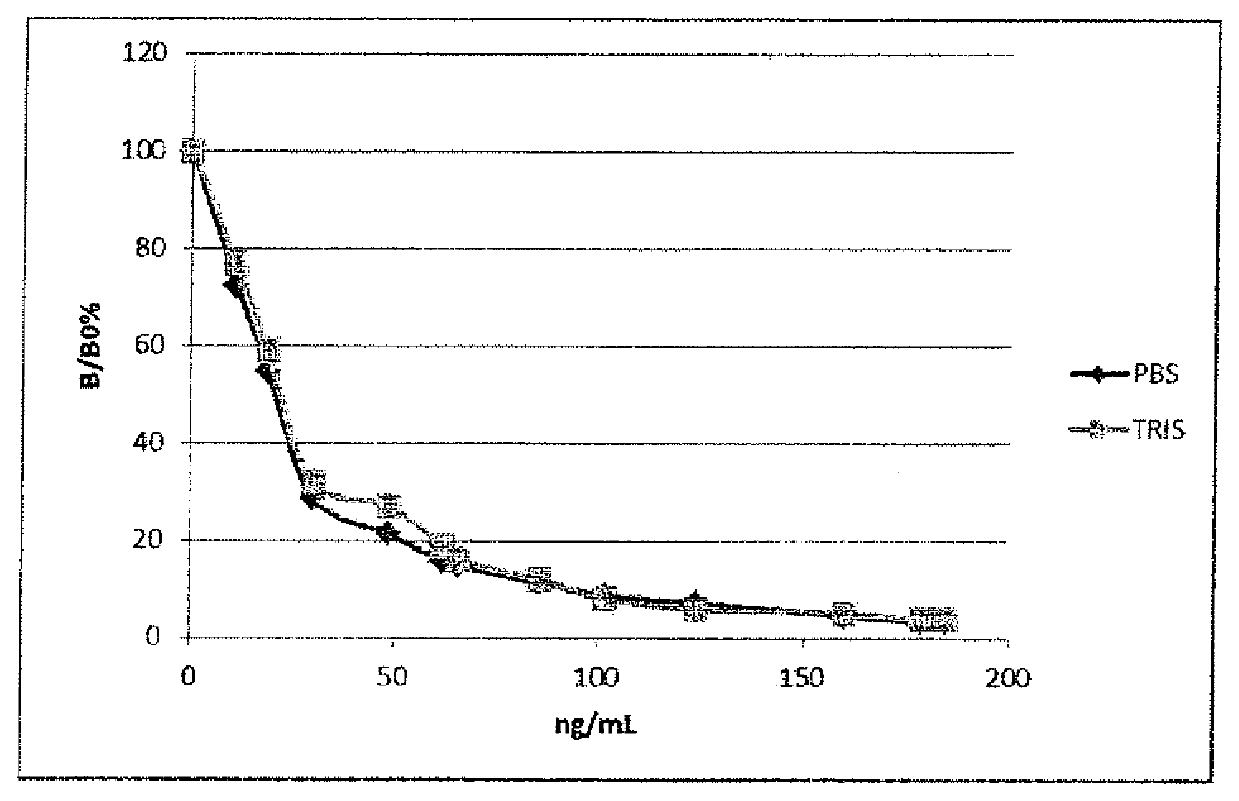Solution for dissociating vitamin D from vitamin-D binding protein, associated detection method and use
a technology of vitamin d and binding protein, applied in the field of detecting vitamin d, can solve the problems of toxic excess vitamin d, in particular due to an overdose, severe illnesses, osteoporosis and rickets, etc., and achieve the effects of effective dissociation, easy operation, and effective release of vitamin d and its metabolites
- Summary
- Abstract
- Description
- Claims
- Application Information
AI Technical Summary
Benefits of technology
Problems solved by technology
Method used
Image
Examples
example 1
OF DISSOCIATION USING A METHANOL AND PERFLUOROHEXANOIC ACID MIXTURE COMPARED WITH PERFLUOROHEXANOIC ACID ALONE
Preparation of Dissociation Solutions
[0092]Comparative dissociation solution: the components for preparing the PBS buffer (5 mM of sodium hydrogen phosphate (Na2HPO4), 1.5 mM of potassium dihydrogen phosphate (KH2PO4), 131 mM of NaCl) and 0.75% perfluorohexanoic acid were dissolved in demineralized water by stirring for about 30 minutes (min). The pH was adjusted to 7.2 using 6N NaOH.
[0093]Solution of the invention: the components for preparing the PBS buffer (5 mM of sodium hydrogen phosphate (Na2HPO4), 1.5 mM of potassium dihydrogen phosphate (KH2PO4), 131 mM of NaCl), 0.75% perfluorohexanoic acid, and 5% of methanol were dissolved in demineralized water by stirring for about 30 min. The pH was adjusted to 7.2 using 6N NaOH.
Method of Quantifying Total 25-0H Vitamin D
[0094]Immunological assays were performed using a Vidas® immunoanalysis machine (from bioMérieux). The singl...
example 2
DIFFERENT ALCOHOLS
[0101]The dissociation solutions used in this example were prepared using the procedure explained for Example 1, in a PBS buffer with pH of 7.2. The natures and the concentrations of the fluoroalkyl surfactant and of the alcohol were varied and are set out in Tables 2 and 3.
[0102]Otherwise, the procedure was as in Example 1.
[0103]
TABLE 2Use of perfluorohexanoic acidsample No. 1sample No. 2at 11 ng / mLat 35 ng / mLComparative dissociation solution: PBS + 1%perfluorohexanoic acid without alcoholMean RFV32242648% ratio RFVNo.2 / RFVNo.1—82%Dissociation solution of the invention: PBS + 1%perfluorohexanoic acid + 5% methanolMean RFV31182323% ratio RFVNo.2 / RFVNo.1—75%Dissociation solution of the invention: PBS + 1%perfluorohexanoic acid + 5% ethanolMean RFV27071925% ratio RFVNo.2 / RFVNo.1—71%Dissociation solution of the invention: PBS + 1%perfluorohexanoic acid + 5% isopropanolMean RFV26332003% ratio RFVNo.2 / RFVNo.1—76%
[0104]It can be seen that adding alcohol, regardless of th...
example 3
OF PERFLUOROALKYL ACID CONCENTRATION
[0107]The dissociation solutions used in this heat exchanger were prepared using the procedure explained for Example 1, in a PBS buffer with pH of 7.2.
[0108]Otherwise the procedure was as in Example 1.
[0109]
TABLE 41.25% perfluorohexanoic1.6% perfluorohexanoic2% perfluorohexanoicacid without methanolacid without methanolacid without methanolsample No. 1sample No. 2sample No. 1sample No. 2sample No. 1sample No. 2at 1 ng / mLat 35 ng / mLat 15 ng / mLat 35 ng / mLat 15 ng / mLat 35 ng / mLMean RFV472438444054288533522252% ratio—81%—71%—67%RFVNo. 2 / RFVNo. 11.25% perfluorohexanoic1.6% perfluorohexanoic2% perfluorohexanoicacid + 5% methanolacid + 5% methanolacid + 5% methanolsample No. 1sample No. 2sample No. 1sample No. 2sample No. 1sample No. 2at 15 ng / mLat 35 ng / mLat 15 ng / mLat 35 ng / mLat 15 ng / mLat 35 ng / mLMean RFV389625893245180225641335% ratio—66%—56%—52%RFVNo. 2 / RFVNo. 1
[0110]It can be seen that the dissociation increases in the presence of alcohol under all...
PUM
 Login to View More
Login to View More Abstract
Description
Claims
Application Information
 Login to View More
Login to View More - R&D
- Intellectual Property
- Life Sciences
- Materials
- Tech Scout
- Unparalleled Data Quality
- Higher Quality Content
- 60% Fewer Hallucinations
Browse by: Latest US Patents, China's latest patents, Technical Efficacy Thesaurus, Application Domain, Technology Topic, Popular Technical Reports.
© 2025 PatSnap. All rights reserved.Legal|Privacy policy|Modern Slavery Act Transparency Statement|Sitemap|About US| Contact US: help@patsnap.com


